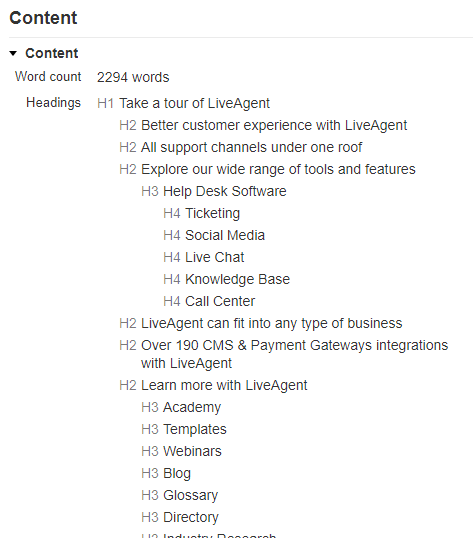the H1 tag
The H1 tag is the main HTML heading tag on a webpage, crucial for SEO and user experience by helping search engines and users understand page content.
What is the H1 tag?
At its core, the H1 tag is an HTML (Hypertext Markup Language) tag that denotes a first-level or main heading on a webpage. This tag, fundamental to web structure, sends a strong signal to search engines about the content of the webpage. Consequently, the H1 tag is not merely suitable for page formatting or structure alone but also serves a crucial function in optimizing the site for search engines.
More than a decorative element, the H1 tag paves the way for search engines to understand your page’s theme and relevance to a user’s search query. Being one of the earliest tags in the HTML language, it forms the pillar of SEO (Search Engine Optimization) practices and is considered by many digital marketers and SEO experts as a cornerstone to effective webpage ranking.
The H1 tag is typically the title of your webpage and should contain keywords relevant to the content of your page. It replaces the traditional print newspaper’s bold headline and provides users and search engines with valuable information about your site’s content. By doing so, the H1 tag enhances the user experience and improves your site’s search engine ranking.
Why is the H1 tag important?
The importance of the H1 tag cannot be overstated as it significantly influences user experience and webpage ranking. It is the first line of text that readers and search engines encounter and therefore, plays a crucial role in communicating the content’s relevance to keywords.
The H1 tag is vital not only for its SEO implications but also for usability and user satisfaction. A clear, representative H1 tag facilitates easy navigation, helping users quickly determine if the page meets their needs. Consequently, a well-crafted H1 tag effectively reduces the bounce rate and increases the engagement level on your site.
Furthermore, the H1 tag guides search engines in understanding the content of a page, which can impact the search rankings positively. Appropriately using the H1 tag with relevant keywords ensures that your webpage is deemed reliable by search engines, increasing its relevance and thus driving more organic traffic to your site.
Types of H1 tags
While the H1 tag itself stands as a singular category within HTML tags, it offers a wide range of use cases depending on how it’s implemented. Fundamental to these variations are differences in positioning, size, HTML attributes, and the inclusion or omission of links within the tag.
In terms of positioning, the H1 tag can appear at the top of the webpage, mimicking a header, or it can appear in the body section of an article. Differing sizes of the H1 tag can be used to denote importance or simply for aesthetic appeal, often larger than lesser headers such as H2 and H3. Importantly, such variations should adhere to SEO best practices to ensure optimal results.
Further customization of the H1 tag is possible using HTML attributes such as “class” and “id”. These attributes permit further styling and navigation functionality in the H1 tag. In terms of content, H1 tags may contain relatable phrases and keywords, helping search engines better index your content, and revealing its relevance to the end user’s search query.
Examples of H1 tags
In a blog post
<h1>The Ultimate Guide to Traveling Europe on a Budget</h1>
On a product page
<h1>Men’s Running Shoes</h1>
On a homepage
<h1>Welcome to Jane’s Baking Blog</h1>
Handy tips about H1 tags
Being familiar with H1 tags and their potential benefits is one thing, but applying this knowledge effectively is another. Here are some essential tips for using H1 tags to your advantage.
Use only one H1 tag per page
Use a single H1 tag per page to keep your page focused and make it easier for search engines to understand your content.
Include keywords in your H1 tag
Your H1 tag should contain your primary keyword to enhance SEO.
Make your H1 tag descriptive
Your H1 tag should accurately reflect the content of your page.
Conclusion
Above all else, remember that your H1 tag does not merely serve a decorative function. It plays a major role in SEO, enhances user experience, and gives your webpage its identity.
The versatility and influence of the H1 tag extend to its positioning on the page, its size, the incorporation of other HTML attributes, and the inclusion of links. So, use your H1 tags wisely and never forget their incredible power.
Knowing how to use the H1 tag correctly could significantly improve your site’s search ranking. That said, misuse of the tag could have the opposite effect. Therefore, it’s vital to implement the handy tips and best practices outlined above in order to fully utilize the potential that H1 tags have to offer.
Frequently asked questions
- Should a page have more than one H1 tag?
While it’s not technically wrong to use more than one H1 tag, from an SEO perspective, it’s best to stick to one H1 tag per page. Multiple H1 tags can confuse search engines and dilute your SEO efforts.
- How do I find the H1 tag on a website?
You can view the H1 tag on a website by right-clicking on the page and selecting 'Inspect' or 'Inspect Element'. This opens the developer tools where you can see the page’s HTML, including the H1 tag.
- Is the H1 tag the same as the title tag?
No, the H1 tag and the title tag are different. The title tag appears in the browser tab and search engine results, while the H1 tag is the main heading visible on the webpage itself.
Optimize Your Website with Proper H1 Tags
Enhance your SEO and user experience by mastering the use of H1 tags. Discover more tips and tools with URLsLab.


